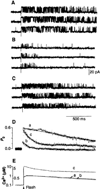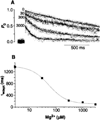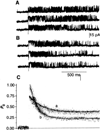Rapid adaptation of cardiac ryanodine receptors: modulation by Mg2+ and phosphorylation
- PMID: 7701323
- PMCID: PMC4242209
- DOI: 10.1126/science.7701323
Rapid adaptation of cardiac ryanodine receptors: modulation by Mg2+ and phosphorylation
Abstract
Channel adaptation is a fundamental feature of sarcoplasmic reticulum calcium release channels (called ryanodine receptors, RyRs). It permits successive increases in the intracellular concentration of calcium (Ca2+) to repeatedly but transiently activate channels. Adaptation of RyRs in the absence of magnesium (Mg2+) and adenosine triphosphate is an extremely slow process (taking seconds). Photorelease of Ca2+ from nitrophenyl-EGTA, a photolabile Ca2+ chelator, demonstrated that RyR adaptation is rapid (milliseconds) in canine heart muscle when physiological Mg2+ concentrations are present. Phosphorylation of the RyR by protein kinase A increased the responsiveness of the channel to Ca2+ and accelerated the kinetics of adaptation. These properties of the RyR from heart may also be relevant to other cells in which multiple agonist-dependent triggering events regulate cellular functions.
Figures




Similar articles
-
Magnesium inhibition of ryanodine-receptor calcium channels: evidence for two independent mechanisms.J Membr Biol. 1997 Apr 1;156(3):213-29. doi: 10.1007/s002329900202. J Membr Biol. 1997. PMID: 9096063
-
Heterogeneity of Ca2+ gating of skeletal muscle and cardiac ryanodine receptors.Biophys J. 1997 Jul;73(1):141-56. doi: 10.1016/S0006-3495(97)78055-X. Biophys J. 1997. PMID: 9199779 Free PMC article.
-
Conducting and voltage-dependent behaviors of the native and purified SR Ca2+-release channels from the canine diaphragm.Biochim Biophys Acta. 1997 Sep 4;1328(2):243-60. doi: 10.1016/s0005-2736(97)00104-1. Biochim Biophys Acta. 1997. PMID: 9315621
-
Ca2+ stores regulate ryanodine receptor Ca2+ release channels via luminal and cytosolic Ca2+ sites.Clin Exp Pharmacol Physiol. 2007 Sep;34(9):889-96. doi: 10.1111/j.1440-1681.2007.04708.x. Clin Exp Pharmacol Physiol. 2007. PMID: 17645636 Review.
-
Cyclic ADP-ribose, the ryanodine receptor and Ca2+ release.Trends Pharmacol Sci. 1995 Nov;16(11):386-91. doi: 10.1016/s0165-6147(00)89080-x. Trends Pharmacol Sci. 1995. PMID: 8578608 Review.
Cited by
-
Hysteresis in voltage-gated channels.Channels (Austin). 2017 Mar 4;11(2):140-155. doi: 10.1080/19336950.2016.1243190. Epub 2016 Sep 30. Channels (Austin). 2017. PMID: 27689426 Free PMC article. Review.
-
Nonequilibrium Enhances Adaptation Efficiency of Stochastic Biochemical Systems.PLoS One. 2016 May 19;11(5):e0155838. doi: 10.1371/journal.pone.0155838. eCollection 2016. PLoS One. 2016. PMID: 27195482 Free PMC article.
-
Mechanisms of cross-talk between G-protein-coupled receptors resulting in enhanced release of intracellular Ca2+.Biochem J. 2003 Sep 1;374(Pt 2):281-96. doi: 10.1042/BJ20030312. Biochem J. 2003. PMID: 12790797 Free PMC article. Review.
-
Inhibition of cAMP-dependent protein kinase under conditions occurring in the cardiac dyad during a Ca2+ transient.Biophys J. 2006 Jul 15;91(2):433-43. doi: 10.1529/biophysj.106.083931. Epub 2006 Apr 21. Biophys J. 2006. PMID: 16632511 Free PMC article.
-
How Ca2+ influx is attenuated in the heart during a "fight or flight" response.J Gen Physiol. 2019 Jun 3;151(6):722-726. doi: 10.1085/jgp.201912338. Epub 2019 Apr 19. J Gen Physiol. 2019. PMID: 31004065 Free PMC article.
References
Publication types
MeSH terms
Substances
Grants and funding
LinkOut - more resources
Full Text Sources
Other Literature Sources
Miscellaneous

